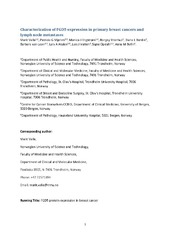| dc.contributor.author | Valla, Marit | en_US |
| dc.contributor.author | Mjønes, Patricia | en_US |
| dc.contributor.author | Engstrøm, Monica J | en_US |
| dc.contributor.author | Ytterhus, Borgny | en_US |
| dc.contributor.author | Bordin, Diana Lilian | en_US |
| dc.contributor.author | van Loon, Barbara | en_US |
| dc.contributor.author | Akslen, Lars A. | en_US |
| dc.contributor.author | Vatten, Lars Johan | en_US |
| dc.contributor.author | Opdahl, Signe | en_US |
| dc.contributor.author | Bofin, Anna M. | en_US |
| dc.date.accessioned | 2019-05-22T11:10:57Z | |
| dc.date.available | 2019-05-22T11:10:57Z | |
| dc.date.issued | 2018 | |
| dc.Published | Valla M, Mjønes P, Engstrøm MJ, Ytterhus B, Bordin DL, van Loon B, Akslen LA, Vatten LJ, Opdahl S, Bofin A M. Characterization of FGD5 expression in primary breast cancers and lymph node metastases. Journal of Histochemistry and Cytochemistry. 2018; 66(11):787-799 | eng |
| dc.identifier.issn | 0022-1554 | |
| dc.identifier.issn | 1551-5044 | |
| dc.identifier.uri | https://hdl.handle.net/1956/19686 | |
| dc.description.abstract | Faciogenital dysplasia 5 (FGD5) amplification drives tumor cell proliferation, and is present in 9.5% of breast cancers. We describe FGD5 expression, assess associations between FGD5 amplification and FGD5 expression, and assess FGD5 expression in relation to proliferation and prognosis. FGD5 immunohistochemistry was done on primary tumors (n=829) and lymph node metastases (n=231) from a cohort of Norwegian patients. We explored associations between FGD5 amplification, FGD5 expression, and proliferation, and analyzed the prognostic value of FGD5 expression by estimating cumulative risks of death and hazard ratios (HRs). We identified nuclear and cytoplasmic expression in 64% and 73% of primary tumors, respectively, and found an association between gene amplification and nuclear expression (p=0.02). The proportion of cases with FGD5 expression was higher in lymph node metastases, compared with primary tumors (p=0.004 for nuclear and p=0.001 for cytoplasmic staining). Neither proliferation nor prognosis was associated with FGD5 expression (age-adjusted HR 1.12 [95% confidence interval = 0.89–1.41] for nuclear expression; and 0.88 [95% CI = 0.70–1.12] for cytoplasmic expression). FGD5 is expressed in a high proportion of breast cancers and lymph node metastases. There was a correlation between FGD5 amplification and nuclear expression, but no association between FGD5 expression and proliferation or prognosis. | en_US |
| dc.language.iso | eng | eng |
| dc.publisher | Sage | eng |
| dc.subject | breast neoplasms | eng |
| dc.subject | Cohort study | eng |
| dc.subject | Prognosis | eng |
| dc.title | Characterization of FGD5 expression in primary breast cancers and lymph node metastases | en_US |
| dc.type | Peer reviewed | |
| dc.type | Journal article | |
| dc.date.updated | 2019-02-18T07:05:56Z | |
| dc.description.version | acceptedVersion | en_US |
| dc.rights.holder | Copyright 2018 The Author(s) | |
| dc.identifier.doi | https://doi.org/10.1369/0022155418792032 | |
| dc.identifier.cristin | 1612539 | |
| dc.source.journal | Journal of Histochemistry and Cytochemistry | |
